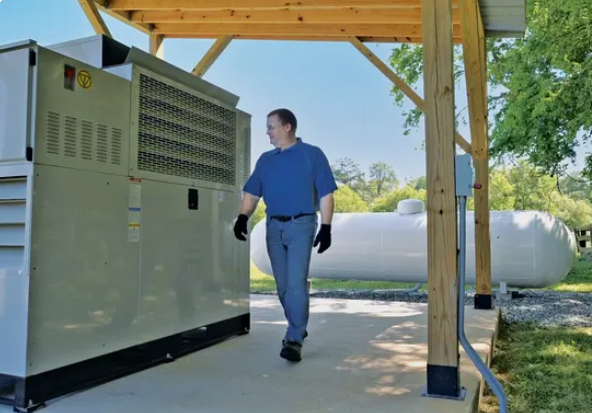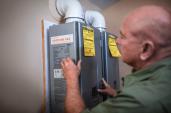Combined heat and power (CHP) systems, once viewed as fringe technology in the residential sector, are gaining new relevance as builders confront rising energy costs, climate-driven power outages, and the need for flexible infrastructure. For propane-powered communities or high-performance homes, micro-CHP (mCHP) offers a compelling solution.
CHP works like this: Propane powers an engine that generates both electricity and usable heat. That heat can be harnessed for domestic hot water, hydronic heating (in floor or ducted), pool warming, or even driveway snow melt. The result is high efficiency and lower utility costs, particularly in homes or facilities with significant thermal demand.
“Think of it like a boiler that also makes electricity,’ says Bert Warner, director of commercial business development at the Propane Education and Research Council (PERC).
While CHP often serves large facilities, mCHP—typically under 50kW—is ideal for residential use where heat demand is high.
Primary Power, Not Just Backup
Unlike standby generators that sit idle until electric service is interrupted CHP units are designed to run continuously. That’s what makes them a better investment, Warner says.
“If you’re only using it for backup, you’re not getting the return. The real value is in using it every day—to power your home and produce heat at the same time,” Warner says.
While commercial sectors like hospitality, health care, and multifamily housing have adopted the technology, single family residential uptake remains limited. Part of the challenge is cost. However, as with any new technology, this equipment is expected to become more affordable over time. The other hurdles are awareness, availability and demand.
“A lot of builders assume this is prototype tech, or they’ve never heard of it at all,” Warner says. “But it’s not experimental. It’s available right now and it works.”
If you are already investing in a standby generator, the incremental cost to move to mCHP might be less than you think.
Where It Makes Sense
In regions with high electricity rates, the financial case for CHP becomes easier to make. The concept of “spark spread”—the difference between different energy costs (electric and propane, for example)—can tip the balance in favor of on-site generation.
Geography also plays a role. Buildings in areas prone to outages, such as Florida or the rural Midwest, stand to gain from the grid independence that CHP offers. And in remote developments where extending utility lines is cost-prohibitive, propane-powered mCHP can serve as a standalone energy source for entire homes—or even clustered developments.
“You’re seeing whole housing communities in places like Myrtle Beach run on propane because natural gas lines can’t be extended,” says Warner. “CHP lets developers move forward without waiting on the utility.”
Design Considerations for Builders
- System size matters. Most residential mCHP units start at around 4.4 kW—best suited for homes 2,000 square feet and up. They’re not ideal for tiny homes or compact apartments unless you are sharing resources across multiple units.
- Thermal load is key. The more domestic hot water and space heat that a building uses, the better the ROI. Think primary residences with large families, homes with pools, or properties with radiant floor heating.
- Integration is straightforward. CHP works well with hydronic heating systems and can be paired with air handlers or heat exchangers for space heating. Out-of-the-box units are often propane-ready or easily adjusted.
- Shared systems possible. With the right engineering, a single unit could theoretically serve multiple homes, using battery storage or a microgrid-style setup.
Funding Programs and Education
PERC is currently offering support through its Propane Construction Research Program, which offsets installation costs of propane-powered equipment by up to $1,000 for residential builders and remodelers. Likewise, PERC’s Alternative Technology and Demonstration Program, geared toward commercial facilities, offers up to $30,000 for installing eligible CHP units. Data collected from U.S. installations will help build case studies to drive future adoption.
Manufacturers such as Axiom, which makes residential units, and 2G Energy, supplying commercial facilities, are active in the market, and PERC offers a directory of units sorted by size and fuel compatibility.
Warner believes the time is now for builders to expand their energy playbook.
“With all the strain on the grid—EVs, electrification, outages—CHP should be in the conversation,” he says. “It’s not just backup. It’s a smart tool for everyday performance.”



